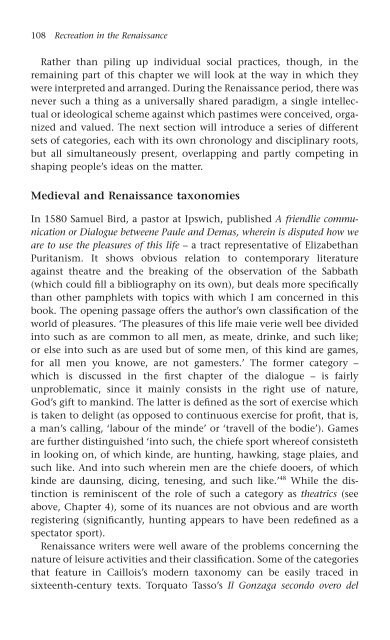Recreation in the Renaissance
Recreation in the Renaissance
Recreation in the Renaissance
- No tags were found...
You also want an ePaper? Increase the reach of your titles
YUMPU automatically turns print PDFs into web optimized ePapers that Google loves.
108 <strong>Recreation</strong> <strong>in</strong> <strong>the</strong> <strong>Renaissance</strong><br />
Ra<strong>the</strong>r than pil<strong>in</strong>g up <strong>in</strong>dividual social practices, though, <strong>in</strong> <strong>the</strong><br />
rema<strong>in</strong><strong>in</strong>g part of this chapter we will look at <strong>the</strong> way <strong>in</strong> which <strong>the</strong>y<br />
were <strong>in</strong>terpreted and arranged. Dur<strong>in</strong>g <strong>the</strong> <strong>Renaissance</strong> period, <strong>the</strong>re was<br />
never such a th<strong>in</strong>g as a universally shared paradigm, a s<strong>in</strong>gle <strong>in</strong>tellectual<br />
or ideological scheme aga<strong>in</strong>st which pastimes were conceived, organized<br />
and valued. The next section will <strong>in</strong>troduce a series of different<br />
sets of categories, each with its own chronology and discipl<strong>in</strong>ary roots,<br />
but all simultaneously present, overlapp<strong>in</strong>g and partly compet<strong>in</strong>g <strong>in</strong><br />
shap<strong>in</strong>g people’s ideas on <strong>the</strong> matter.<br />
Medieval and <strong>Renaissance</strong> taxonomies<br />
In 1580 Samuel Bird, a pastor at Ipswich, published A friendlie communication<br />
or Dialogue betweene Paule and Demas, where<strong>in</strong> is disputed how we<br />
are to use <strong>the</strong> pleasures of this life – a tract representative of Elizabethan<br />
Puritanism. It shows obvious relation to contemporary literature<br />
aga<strong>in</strong>st <strong>the</strong>atre and <strong>the</strong> break<strong>in</strong>g of <strong>the</strong> observation of <strong>the</strong> Sabbath<br />
(which could fill a bibliography on its own), but deals more specifically<br />
than o<strong>the</strong>r pamphlets with topics with which I am concerned <strong>in</strong> this<br />
book. The open<strong>in</strong>g passage offers <strong>the</strong> author’s own classification of <strong>the</strong><br />
world of pleasures. ‘The pleasures of this life maie verie well bee divided<br />
<strong>in</strong>to such as are common to all men, as meate, dr<strong>in</strong>ke, and such like;<br />
or else <strong>in</strong>to such as are used but of some men, of this k<strong>in</strong>d are games,<br />
for all men you knowe, are not gamesters.’ The former category –<br />
which is discussed <strong>in</strong> <strong>the</strong> first chapter of <strong>the</strong> dialogue – is fairly<br />
unproblematic, s<strong>in</strong>ce it ma<strong>in</strong>ly consists <strong>in</strong> <strong>the</strong> right use of nature,<br />
God’s gift to mank<strong>in</strong>d. The latter is def<strong>in</strong>ed as <strong>the</strong> sort of exercise which<br />
is taken to delight (as opposed to cont<strong>in</strong>uous exercise for profit, that is,<br />
a man’s call<strong>in</strong>g, ‘labour of <strong>the</strong> m<strong>in</strong>de’ or ‘travell of <strong>the</strong> bodie’). Games<br />
are fur<strong>the</strong>r dist<strong>in</strong>guished ‘<strong>in</strong>to such, <strong>the</strong> chiefe sport whereof consisteth<br />
<strong>in</strong> look<strong>in</strong>g on, of which k<strong>in</strong>de, are hunt<strong>in</strong>g, hawk<strong>in</strong>g, stage plaies, and<br />
such like. And <strong>in</strong>to such where<strong>in</strong> men are <strong>the</strong> chiefe dooers, of which<br />
k<strong>in</strong>de are dauns<strong>in</strong>g, dic<strong>in</strong>g, tenes<strong>in</strong>g, and such like.’ 48 While <strong>the</strong> dist<strong>in</strong>ction<br />
is rem<strong>in</strong>iscent of <strong>the</strong> role of such a category as <strong>the</strong>atrics (see<br />
above, Chapter 4), some of its nuances are not obvious and are worth<br />
register<strong>in</strong>g (significantly, hunt<strong>in</strong>g appears to have been redef<strong>in</strong>ed as a<br />
spectator sport).<br />
<strong>Renaissance</strong> writers were well aware of <strong>the</strong> problems concern<strong>in</strong>g <strong>the</strong><br />
nature of leisure activities and <strong>the</strong>ir classification. Some of <strong>the</strong> categories<br />
that feature <strong>in</strong> Caillois’s modern taxonomy can be easily traced <strong>in</strong><br />
sixteenth-century texts. Torquato Tasso’s Il Gonzaga secondo overo del










